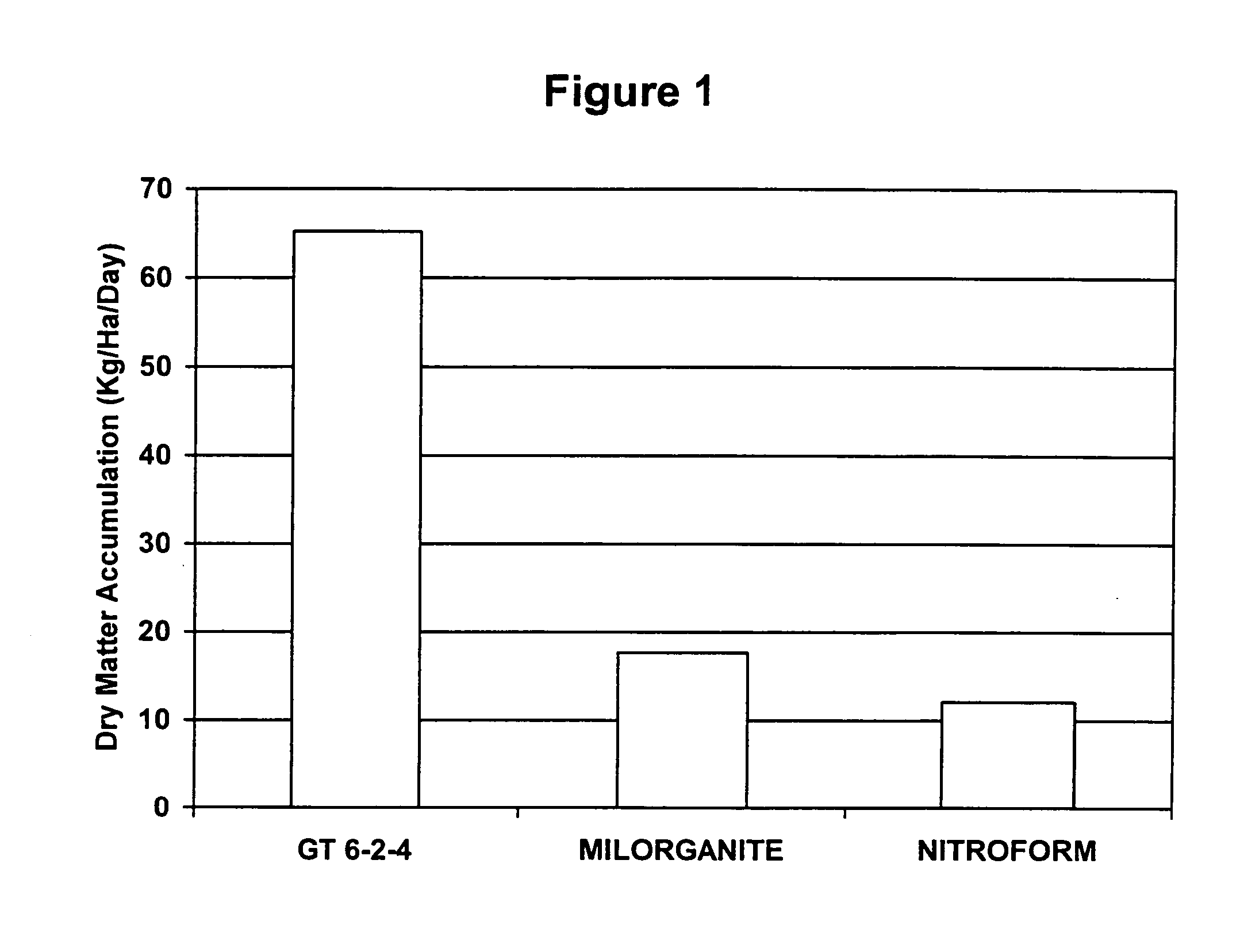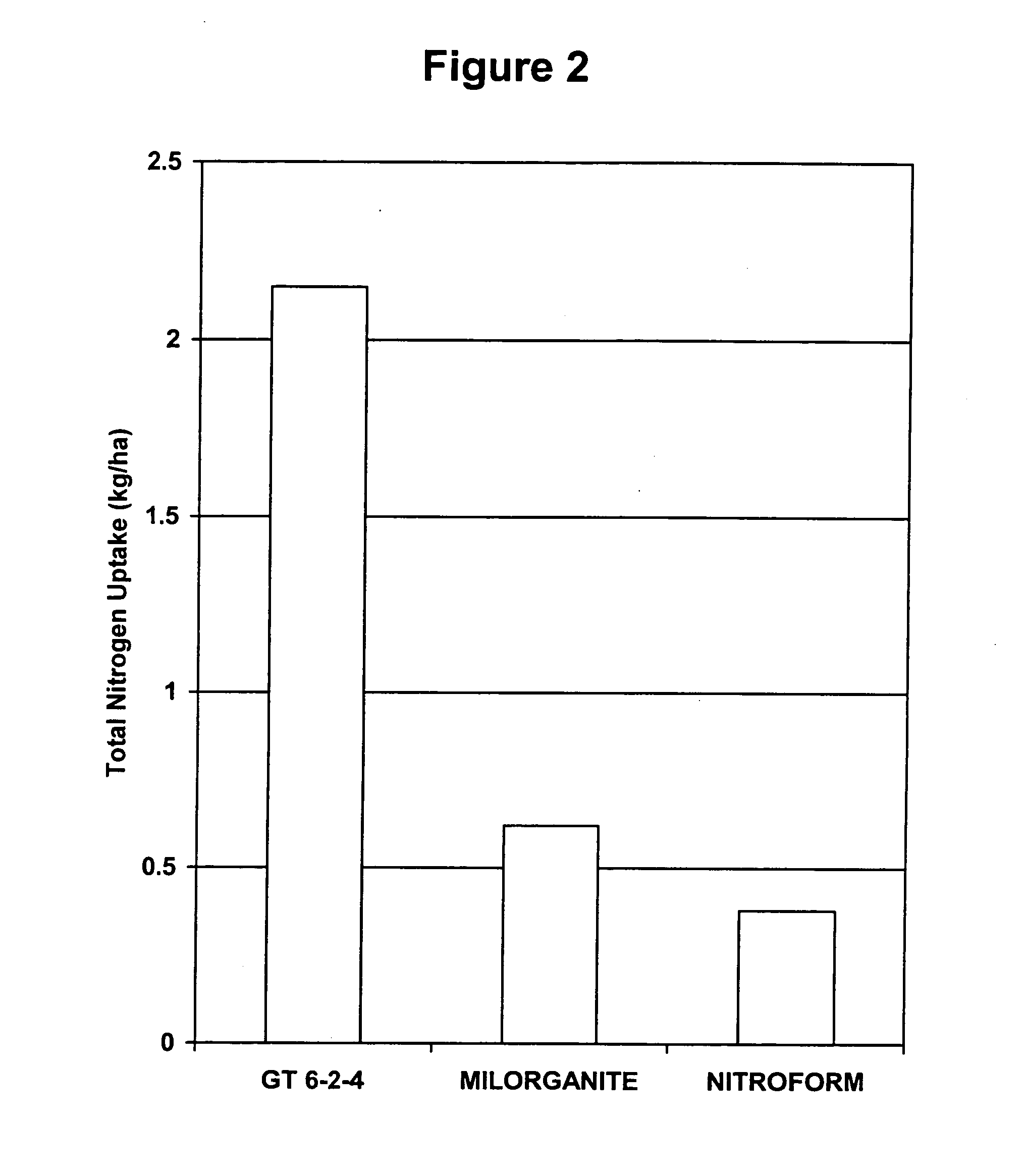Organic-based fertilizer
a fertilizer and organic technology, applied in the field of organic fertilizer, can solve problems such as the variety of ecological problems
- Summary
- Abstract
- Description
- Claims
- Application Information
AI Technical Summary
Benefits of technology
Problems solved by technology
Method used
Image
Examples
example 1
Materials and Methods
[0039] Fertilizers produced according to the subject invention were evaluated to compare the quality, growth and N uptake response of three slow-release N sources. On a comparative basis, the Green Technologies, Inc. granular slow-release fertilizer (GT-6-2-4) produced higher visual quality, growth rate, and total N uptake during two 56-day evaluation cycles than did MILORGANITE or NITROFORM.
[0040] GT-6-2-4 released its N over an extended period and induced acceptable growth and quality responses in turfgrass. Acceptable levels of quality and growth can be attained when the material is applied at 1.5 lbs N / 1000 sq ft of 56-day cycles, but it was noted that the second 56-day cycle produced higher visual quality turf than did the first evaluation cycle. Even though the visual quality ratings for the second 56-day evaluation period were higher, the dry matter production of the turfgrass in response to the GT-6-24 was equivalent to the first evaluation cycle. This...
example 2
Visual Quality Ratings
[0042] First Evaluation Cycle: Differences in visual quality relative to treatment were observable within 7 days after application, and the visual differences in the materials were retained throughout the evaluation period. By 14 days after application, statistical differences relative to the N source applied were noted. The GT-6-2-4 material produced a higher visual quality than did the NITROFORM at 14 days after application. A similar trend relative to the influence of N sources on visual quality was noted at 21 days after application. Visual quality of the turfgrass receiving MILORGANITE had improved by 28 days after application and was statistically equivalent to the experimental material. By 28 days after application, the turfgrass receiving the GT-6-24 had attained a quality rating of 5.7 (which is above the minimum acceptable level of 5.5). GT-6-2-4 produced the highest overall mean visual quality rating (MVQR) of the three slow-release N sources during...
example 3
Dry Matter Production and N Uptake
[0044] First Evaluation Cycle: Clippings were taken at 28, 42, and 56 days after application of the N sources. Clippings were dried and weighed for dry matter production estimates. Similar trends across all three collections were observed. Total dry matter production of the three collections are presented in FIG. 1. Large differences in dry matter production were noted among the N sources applied. GT-6-2-4 produced almost 4-fold more dry matter than did the other two slow-release N sources. This material appears to be unique in its properties in that it is capable of inducing a quality turfgrass over an extended period of time with good growth characteristics. Even though a superior growth rate was attained, the turfgrass did not accumulate an excessive amount of N in its tissue, as evidenced by the data presented in FIG. 2. A turfgrass containing 3.09% N in the tissue is not considered to have excessive N content. Total N uptake followed the same ...
PUM
| Property | Measurement | Unit |
|---|---|---|
| temperatures | aaaaa | aaaaa |
| quality homogenous | aaaaa | aaaaa |
| dry soluble | aaaaa | aaaaa |
Abstract
Description
Claims
Application Information
 Login to View More
Login to View More - R&D
- Intellectual Property
- Life Sciences
- Materials
- Tech Scout
- Unparalleled Data Quality
- Higher Quality Content
- 60% Fewer Hallucinations
Browse by: Latest US Patents, China's latest patents, Technical Efficacy Thesaurus, Application Domain, Technology Topic, Popular Technical Reports.
© 2025 PatSnap. All rights reserved.Legal|Privacy policy|Modern Slavery Act Transparency Statement|Sitemap|About US| Contact US: help@patsnap.com



